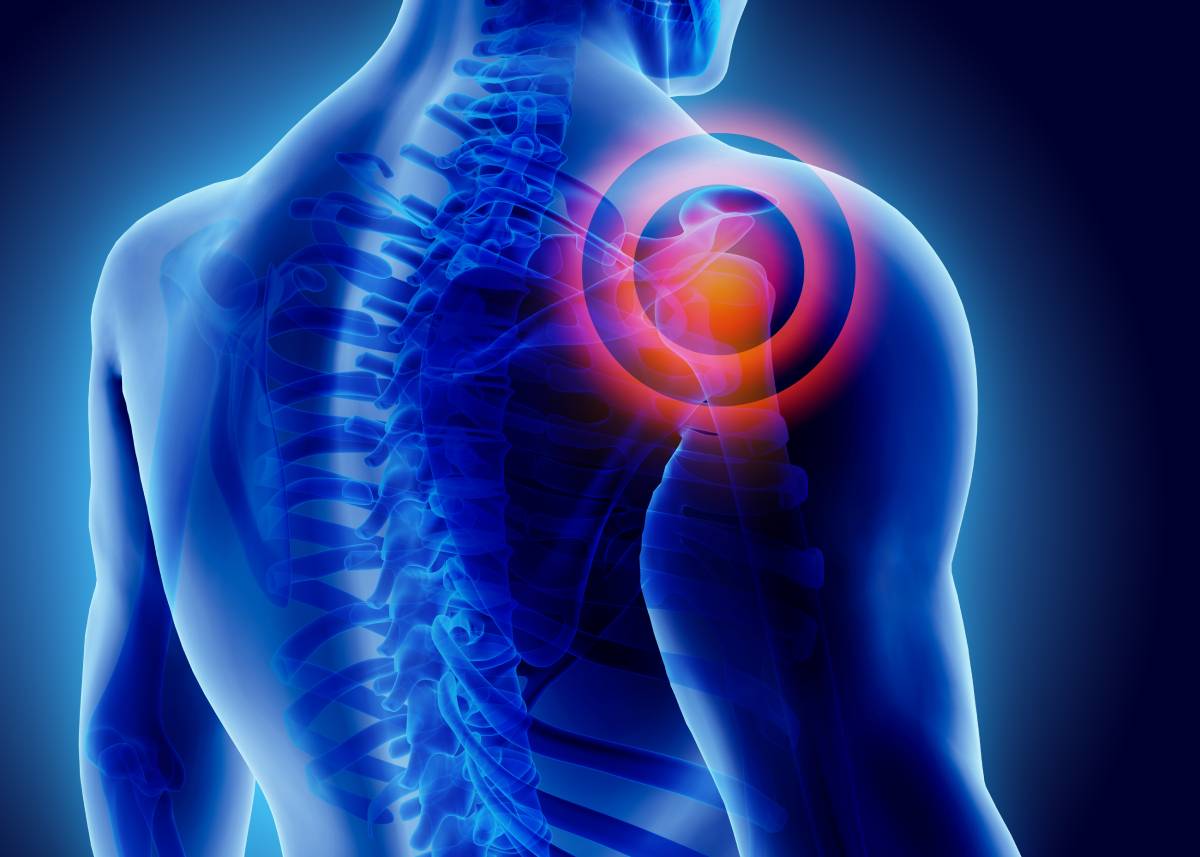Shoulder pain is a common experience that can range from being a mild nuisance to severely impacting function and quality of life. Shoulder pain can be caused by a number of different underlying conditions, and the treatment options for an individual can depend on what their diagnosis is. Home remedies like ice therapy, over-the-counter pain relief, and stretching are often sufficient for mild injury, while other patients may require injections or even surgery to manage symptoms (1).
The shoulder encompasses multiple bones and a large number of muscles, tendons, ligaments, and other tissues. It is a highly flexible joint, but as a result of this, it is also relatively vulnerable to injury or dysfunction. Injury, overuse, normal deterioration with age, and musculoskeletal disease can all cause shoulder pain. Less frequently, pain may be due to a tumor or infection (1).
One important consideration for shoulder injuries is that the risk of injury increases after the first, especially for dislocation. Thus, prevention is an essential facet. Maintaining strength and flexibility, as well as avoiding situations that overload the joint, help protect the shoulder from re-injury and returning pain (1). Exercise, physical therapy, and activity modification can also protect against instability in any patient and can improve symptoms in several shoulder conditions, including shoulder impingement, rotator cuff disorders, and frozen shoulder (1-4).
Shoulder pain that is a result of inflammation can often be managed fully or partially by home remedies. Ice and compression reduce swelling and related pain. Rest or reducing activity can allow the tissues in the joint to recover on their own in some cases. Over-the-counter NSAIDs also directly reduce inflammation. These are good treatment options for, as an example, someone who experiences mild shoulder pain after a day of unusually high levels of shoulder use, whether from manual work or sports. The underlying condition may be acute tendinitis or bursitis. These home remedies can also be part of a treatment regimen for those with chronic pain, such as from osteoarthritis, alongside other therapies (1,2,4,5).
More severe instances of inflammatory shoulder pain may require medical intervention. A common and effective treatment is corticosteroid injection. Steroids have strong anti-inflammatory effects. When they are injected into the joint directly, patients can experience significant pain relief and improved function that lasts for multiple months (2,4,5). Low laser therapy and shockwave therapy are also used to a lesser extent to reduce joint inflammation and pain; these techniques are similarly performed by trained professionals (2-4).
Physiatrists can also administer platelet-rich plasma injections and hyaluronic acid injections, which both address a different element that may be causing a patient’s pain. In the former technique, compounds in a patient’s own blood are extracted and injected into the injured joint; the motivation is that these compounds will stimulate natural healing processes and help repair the damaged cartilage, tendon, ligament, or muscle (2). The latter therapy is used when patients with arthritis have low levels of natural hyaluronic acid in their joint, leading to impaired lubrication and shock absorption; restoring these functions can reduce pain and stiffness. Hyaluronic acid injections are more commonly used for knee arthritis, but both types can be used for shoulder pain as well if indicated.
Finally, some patients may need surgery for shoulder pain. Severe injury, such as a fractured bone or torn ligament/tendon usually warrants early surgical intervention, followed by physical therapy and pain management. Extensively damaged joints may need to be fully replaced (1,2). Some patients may be referred for a shoulder arthroscopy to remove a small amount of tissue and relieve compression in the joint, but a recent study suggested that this treatment may not generate clinically important improvements (6).
References
- Athwal GS, Widmer B. “Shoulder Pain and Common Shoulder Problems,” OrthoInfo, 2018. https://orthoinfo.aaos.org/en/diseases–conditions/shoulder-pain-and-common-shoulder-problems/
- Murphy RJ, Carr AJ. Shoulder pain. BMJ Clinical Evidence, 2010, 2010:1107. PMID: 21418673
- Hawk C, Minkalis AL, Khorsan R, et al. Systematic Review of Nondrug, Nonsurgical Treatment of Shoulder Conditions. Journal of Manipulative and Physiological Therapeutics, 2017, 40(5): 293-319. DOI: 10.1016/j.jmpt.2017.04.001
- Steuri R, Sattelmayer M, Elsig S, et al. Effectiveness of conservative interventions including exercise, manual therapy and medical management in adults with shoulder impingement: a systematic review and meta-analysis of RCTs. British Journal of Sports Medicine, 2016, 51(18):1340-1347. DOI: 10.1136/bjsports-2016-096515
- Sun Y, Chen J, Li H, et al. Steroid Injection and Nonsteroidal Anti-inflammatory Agents for Shoulder Pain. Medicine, 2015, 94(50): e2216. DOI: 10.1097/MD.0000000000002216
- Beard DJ, Rees JL, Cook JA, et al. Arthroscopic subacromial decompression for subacromial shoulder pain (CSAW): a multicentre, pragmatic, parallel group, placebo-controlled, three-group, randomised surgical trial. The Lancet, 2018, 391(10118):329-338. DOI: 10.1016/S0140-6736(17)32457-1
